Provisioning, or what landlubbers call “grocery shopping” is one of the joys and pains of cruising. On the one hand, it’s not that easy to keep a boat stocked with nutritious and delicious food, when you never know how or when you’ll get to stock up. We have a cramped fridge that is more like a cabinet than a refrigerator, no freezer, and my “pantry” consists of storing food wherever I can get it (pasta underneath the cushions, canned goods behind the seat backs, glass containers underneath the galley counter, wine in the bilge). On the other hand, every new country you go to there are new delights at the store and outdoor markets to explore. It’s a culinary adventure. Moreover, you get to interact with the locals in a different way than you would if you were simply on vacation. I love seeing what every new country has to offer as it’s a peek into their culture.
Every country has its specialties and local tastes, and these are reflected in what is available to buy. I loved that every Mexican grocery store had 10+ different kinds of refried beans (who knew there were so many choices?) and dozens of different kinds of salsa. There would also be a cooler in the bakery section of Mexican grocery stores, and those in the know would open it up to reveal warm bundles of freshly-made corn and flour tortillas. Aside the cooler would be bags of freshly fried tortilla chips and handmade salsa. In Georgia they had half an aisle devoted to grits. In Spain they love their ham (jamon) and will often have a person devoted to selling whole ham legs. In France, of course the cheese section is amazing (albeit intimidating) and their wine aisle is a whole store in and of itself. I also love how in Europe there are often daily markets in towns where you can get fresh fruits and vegetables, as well as other things such as olives, bread, wine, and even flowers.
The grocery store in the San Blas Islands came to us in a canoe. Fresh vegetables and fruits were laid out and you could order by pointing and letting them know how much you wanted. They’d weigh it and voila! Shortest commute to the store, ever. Believe it or not, before cruising in the San Blas, I’d never eaten a fresh passion fruit before, but I’m hooked now. Cut the top off of one and the seedy pulp inside has its own little bowl. Panamanian pineapples and papaya are pretty delicious too. Their limes are also interesting as they’re orange on the inside instead of green. Squeeze one of those puppies on a papaya and you have breakfast. (Or, squeeze one of those in a glass with sugar and rum and you have lunch called “tea punch”.)
Jamaica has an amazing selection of fruits and vegetables, and the outdoor markets are awesome. Tourists may stroll in these markets from time to time, but it’s only cruisers who go to the markets and buy in bulk. The Jamaican women selling fruits and vegetables were more than glad to give recipes or explain a fruit or vegetable that didn’t look familiar. For the first time we tried things such as ackee, soursop, callaloo and orantiques. There was a man who came by the marina in Montego Bay named Tony (but who went by the name “The Juice Mon”) and he made fresh squeezed juices, bottled them in old liquor bottles and delivered them to your boat. They were the best juices I’d ever tasted in my life. I now dream about soursop juice.
Puerto Rico was interesting because it had a lot of imports from the mainland United States, yet it also had a lot of local food and food suited to local tastes. You could get Frosted Flakes and plantains in the same store. The Bahamas was difficult to provision because they simply can’t grow a lot of food there. Some local farmers will sell fruits and vegetables out of the back of their trucks or on roadside stands. Items in the grocery store that aren’t local (and most aren’t) are really expensive because so much is shipped in. We were desperate for spaghetti and I bought a can of Hunts tomato sauce for $5.00. However, because the Bahamaians make so much macaroni and cheese, their cheddar cheese is amazingly cheap! Cream is cheap too since they make their macaroni and cheese with heavy cream. You have to be willing to switch to local foods and brands otherwise pay a premium.
I have to admit, I was really happy to be back in an American grocery store when we made landfall in Florida. Fresh, organic spinach! Berries! Bagels and whipped cream cheese! The Publix grocery store chain in Florida is a really good one, and it has an organics section, a bakery and even free wifi. I also took for granted what great prices we have in the United States. We spent the equivalent of $700 on two grocery carts full of food in Montego Bay, Jamaica that probably would have cost half that in the U.S.
Getting to a grocery store or market and getting back to the boat can be interesting. Whenever we’ve rented a car we’ve made sure to do a provisioning run. Normally we walk to the store or market, but sometimes we have too much to carry back by ourselves. In San Juan, Puerto Rico, I made a huge provisioning run (two grocery carts filled to bursting), but the grocery store was several miles away from the marina. However, they had a great service where if you spent more than $50, they would give you a ride back home. (Or, in our case, they gave us a ride back “boat.”) Once in a while you find a store that will deliver to a marina. Sometimes we dinghy ashore to go shopping and have to load everything up in the dinghy and hope it doesn’t get soaked on the ride to the boat. Now that we’re in Europe I’ve bought a little hand cart to pick up the shopping (Thanks Suella of 2 Blue for the tip on where to get one!). (With limited room on board, I have to store the cart in the shower.)
Once we get all of the groceries on board, it takes a while to put everything away. In the tropics you have to be careful about bugs and temperature. We never bring any cardboard on the boat for fear of getting infested with cockroaches because they lay their eggs in the cardboard. I had to store our flour in the refrigerator for fear of getting weevils. In Puerto Rico I inadvertently bought some pasta that had weevils in it, but fortunately I had bagged the pasta in separate plastic bags so they were contained. Those little guys are really ugly. We also had to store our entire chocolate hoard in the fridge otherwise it would melt into a single block. One thing we have discovered on this trip is that chocolate (in its many forms) is truly an essential provision.
I usually wash fruit in the sink with an iodine solution and then I will wrap the fruit in aluminum foil and put it in a “green” bag (that helps retard food spoilage). I have to dunk bunches of bananas to get the spiders out. Stored this way oranges (for example) can last for two months.
I know I’m biased, but Italy looks like it might be my favorite place for provisioning…stay tuned…I promise to post pictures!

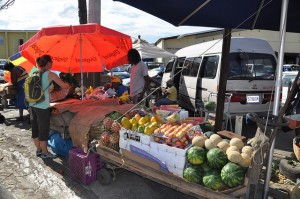
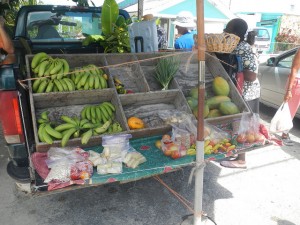
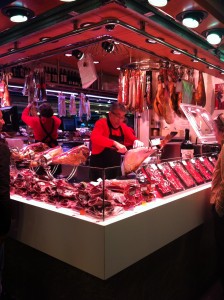
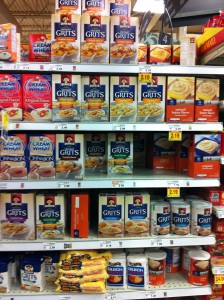
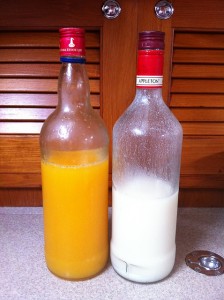
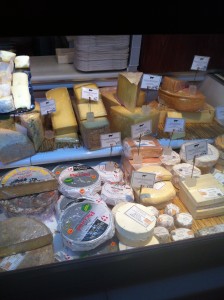
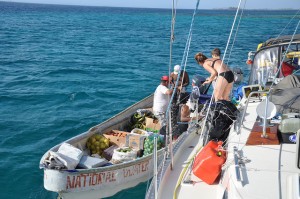
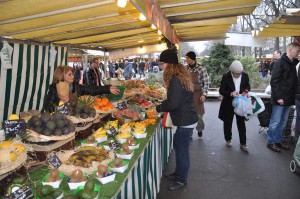

Comments
One response to “Provisioning (AKA Grocery Shopping)”
Awesome post! What adventures you have had–can’t believe it has already been 1 1/2 years!!! Enjoy Italy.